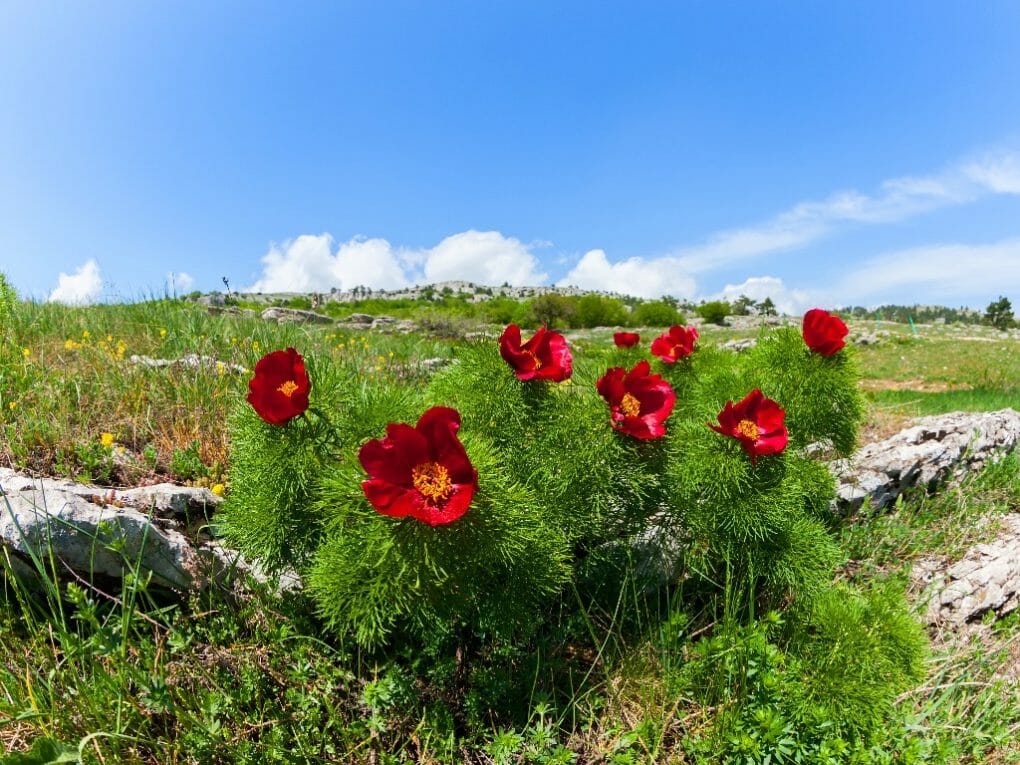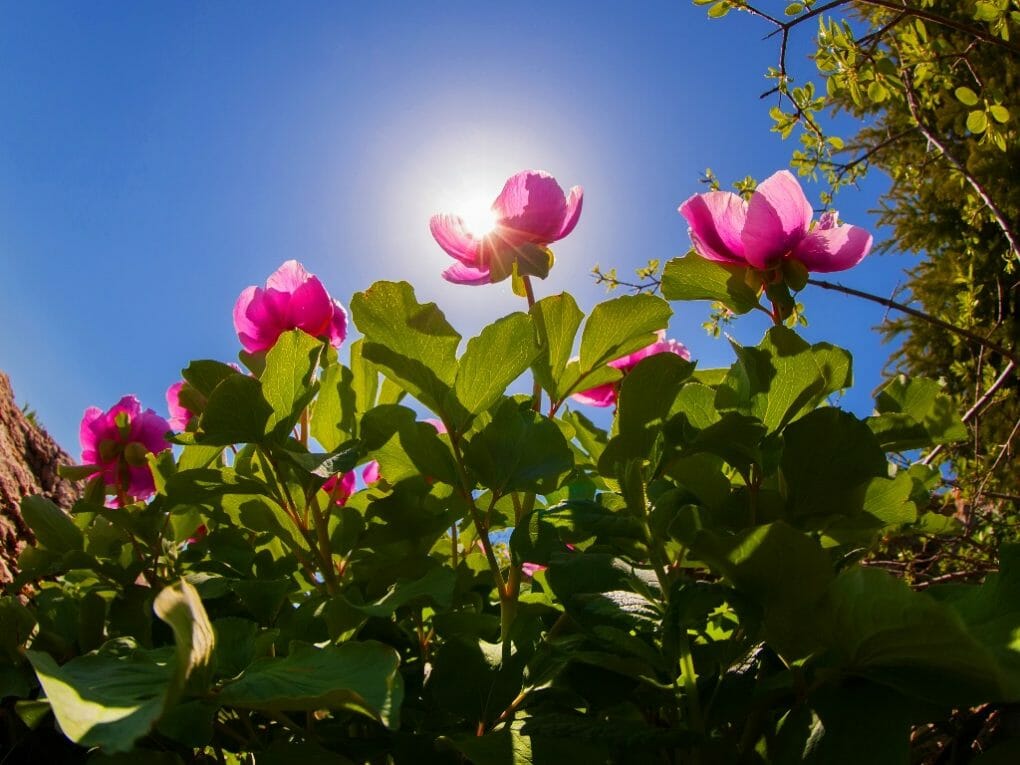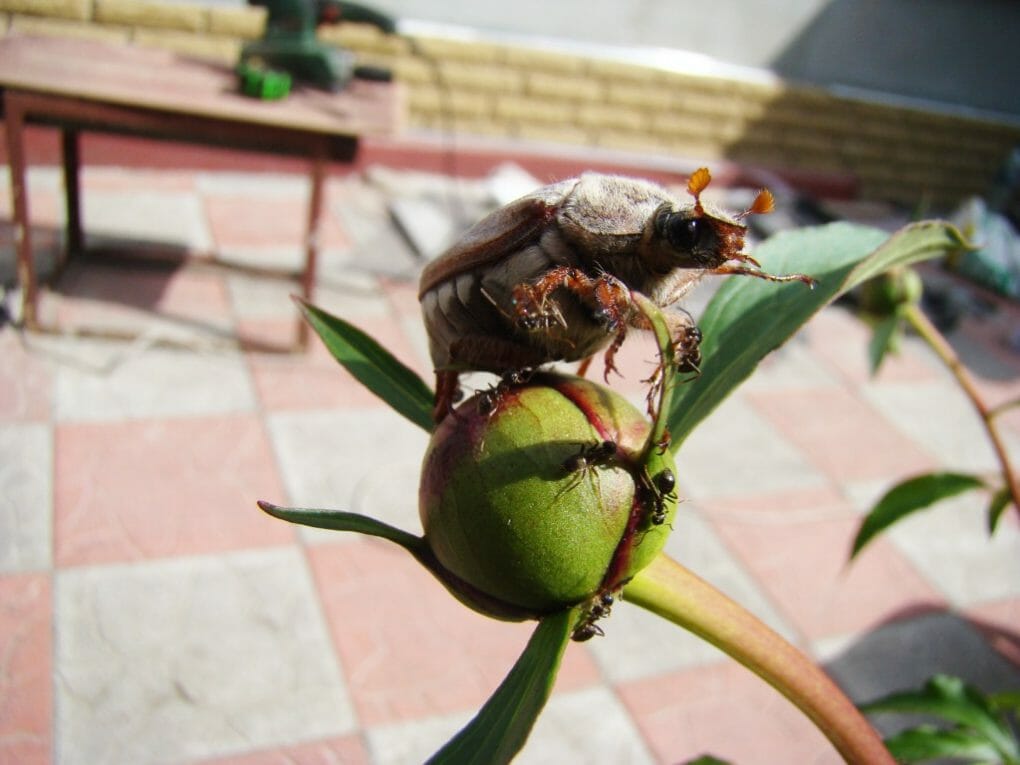Peony Growing Zone

Peonies that grow from a herbaceous base require a cold or cool-temperate climate and an amount of winter chill sufficient to cause dormancy and the formation of flower buds. If the climate is considered “too warm,” this indicates that winters are too short, which can cause plants to either not flower or die. Peonies have a good chance of flourishing in the coastal and certain interior regions of Alaska and in many areas of Canada and the northern two-thirds of the United States of America.
- Zone 3 to 6 ( -40 to -0 °F or -40 to -17.8°C) – is ideal for planting herbaceous peonies.
- Zone 7 (0 to 10 °F or -17.8 to -12.2°C)– Good for wide varieties.
- Zone 8 ( 10 to 20°F or -12.2 to -6.7°C)- Some peony hybrids from the Itoh group and the Lactiflora zone might do well in this zone.
- Zone 9 (20 to 30°F or -6.7 to -1.1°C)– Peonies are not likely to thrive in climates classified as zone 9 or higher.
Table of Contents
Growing Peonies in USDA Zone 8
Tree peonies typically bloom from late February to early March. Herbaceous peonies begin to bloom on April 1st.
Growers have succeeded with many peony forms, including tree, herbaceous, and intersectional varieties. Itoh hybrids are also known as intersectional peonies.
All vegetation has suffered due to the 2011 drought and 2012’s record-breaking heat wave.
Stress may have contributed to the demise of tree peonies aged 6-7 years. Despite the drought, the ‘Snow Lotus’ tree peony has performed remarkably well.
Despite Texas’s arid climate, the rockii tree peony ‘Snow Lotus’ has thrived year after year.
Since ‘Snow Lotus’ is a domesticated form of the wild species Paeonia rockii, it stands to reason that it would be more drought- and stress-resistant than other tree peony varieties because of its ancestry. Northwestern China, namely Gansu province, is where P. rockii was first discovered. This is an arid region of China, with an annual precipitation of only 12 inches. This is only about half the amount of rain that Dallas, Texas, got during the drought that year.
Despite Texas’s arid climate, the rockii tree peony ‘Snow Lotus’ has thrived year after year. Since ‘Snow Lotus’ is a domesticated form of the wild species Paeonia rockii, it stands to reason that it would be more drought- and stress-resistant than other tree peony varieties because of its ancestry. Northwestern China, namely Gansu province, is where P. rockii was first discovered. This is an extremely dry region of China, with an annual precipitation of only 12 inches. Dallas, Texas, received less than half of that amount during the drought that year.
So, if you live in a hot, dry area and want to plant some tree peonies, you should look into the rockii or Gansu Chinese tree peonies. Peonies are a popular flowering herb that can be cultivated here without any extra care.
Best Time To Plant

The best time to plant is in either late January or February or in the winter months of November or December.
Selecting a Location
Warmer climates are ideal for planting peonies since they provide some relief from the intense afternoon light in the summer. Morning sun and afternoon shade are excellent, as we recommend for all growing zones. If this isn’t an option, peonies should be planted beside a tall shrub to provide shade from the scorching sun.
Watering
At least two weekly, in-depth waterings in the spring and summer, with extra watering as needed. That’s especially crucial for young peonies.
None of the major pests or diseases have made an appearance.
Tips
At the start of November, rake up any stray tree peony leaves that haven’t fallen. Trim the stalks and leaves of herbaceous peonies right down to the soil.
You should plant your herbaceous peonies so that the ‘eyes,’ or buds, are just below the soil’s surface and are covered by a thin layer of dirt or mulch at most.
Peonies in USDA Zone 8b to 9
Average Flowering Time
This decade-long study of blooms in Sebastopol, California, yielded the following events. Flowering begins in late February or early March for P. tenuifolia and related hybrids like ‘Early Scout. Flowering Chinese tree peonies around the middle of March. The first 15 days of April are ideal for P. peregrina hybrids, such as the corals known as “Coral Charm” and “Coral ‘n Gold.” In early April, you can see Japanese tree peonies and P. lutea. Herbaceous peonies of the P. lactiflora type bloom at their best from the middle of May until early June, whereas intersegmental peonies bloom at their best from May 1st through the 10th.
Suggestions for Peony Varieties To Plant
Better pinpoint your planting zone with a precise map, like the one in Sunset’s garden zone guide. This indicator provides far more specific guidance than the USDA’s hard-and-fast zone system. The cities of San Francisco and Sebastopol, California, are both in USDA hardiness zone 8. On the other hand, herbaceous peonies might be difficult to grow in San Francisco, in contrast to the tree and intersectional peonies. Herbaceous peonies get a good winter chill in Sebastopol, which is just a bit north of the same USDA planting zone, allowing consistent blooming. On the other hand, very late-season cultivars need to be better suited to the early June heat and tend to wilt fast.
A gardener in San Francisco has reported success with the earlier flowering forms of herbaceous peony. Once a week in December and January, she empties a bag of ice on top of her dormant plants. As a result, the plants will have the ideal amount of time to chill before blooming.
Best Time To Plant
Late November through early February is ideal for planting. It is best to plant in a site that receives both full sun and some shade. In hotter, brighter climates, peony leaves will scorch in the summer.
Use microclimates to your advantage by creating cooler planting sections in your zone 9 garden, especially in warmer areas. You can increase your plant’s growth range by planting it in a cool, sheltered spot, like at the foot of a hill.
In summer, zone 8b gardens need only one or two in-depth waterings per week. The peonies you just planted need extra TLC.
Watering is needed in the late spring, summer, and early fall in the warmer sections of zone 9. For optimal results, do this manually or with drip irrigation at a rate of one gallon per plant daily. As a barrier between soil and air, mulch helps reduce water loss due to evaporation.
Diseases and Pests

March showers might bring on an epidemic of botrytis. If there is a lot of rain, multiple applications of Actionovate or copper-sulfate may be required to control the problem.
Although gophers won’t touch the roots of peonies, they’ll gladly devour the rest of your garden. Peony roots are vulnerable to tunneling by these pests.
Other suggestions include mowing down intersectional and herbaceous peonies in November to induce dormancy. If you have tree peonies, you should pick off their leaves now, but you should be careful not to damage the woody stems. Cutting back the foliage stimulates the plant to produce new flower buds, just like the natural fall of deciduous leaves does in colder climates. Foliage removal is necessary for peonies to recover.
Peony Varieties
Varieties | USDA Hardiness Zone |
|---|---|
Paeonia ‘Abalone Pearl’ | Zone 3-8 |
Paeonia ‘America’ | Zone 3-8 |
Paeonia ‘Athena’ | Zone 3-8 |
Paeonia ‘Bartzella’ (Itoh Peony) | Zone 4-9 |
Paeonia ‘Blaze’ | Zone 3-8 |
Paeonia ‘Buckeye Belle’ | Zone 3-8 |
Paeonia ‘Burma Ruby’ | Zone 3-8 |
Paeonia ‘Chocolate Soldier | Zone 3-8 |
Paeonia ‘Claire de Lune’ | Zone 3-8 |
Paeonia ‘Cora Louise’ | Zone 4-9 |
Paeonia ‘Coral Charm’ | Zone 3-8 |
Paeonia ‘Coral n’ Gold’ | Zone 3-8 |
Paeonia ‘Coral Sunset’ | Zone 3-8 |
Paeonia ‘Coral Supreme’ | Zone 3-8 |
Paeonia ‘Cytherea’ | Zone 3-8 |
Paeonia ‘Early Scout’ | Zone 3-8 |
Paeonia ‘First Arrival’ | Zone 4-9 |
Paeonia ‘Flame’ | Zone 3-8 |
Paeonia ‘Garden Treasure’ | Zone 4-9 |
Paeonia ‘Golden Glow’ | Zone 3-8 |
Paeonia ‘Henry Bockstoce’ | Zone 3-8 |
Paeonia ‘Illini Warrior’ | Zone 3-8 |
Paeonia ‘Julia Rose’ | Zone 4-9 |
Paeonia ‘Kansas’ | Zone 3-8 |
Paeonia “Lemon Chiffon’ | Zone 3-8 |
Paeonia ‘Lovely Rose’ | Zone 3-8 |
Paeonia ‘Many Happy Returns’ | Zone 3-8 |
Paeonia ‘Merry Mayshine’ | Zone 3-8 |
Paeonia ‘Paula Fay’ | Zone 3-8 |
Paeonia ‘Pink Derby’ | Zone 3-8 |
Paeonia ‘Pink Hawaiian Coral’ | Zone 3-8 |
Paeonia ‘Port Royale’ | Zone 3-8 |
Paeonia ‘Prairie Charm’ (Itoh Peony) | Zone 4-9 |
Paeonia ‘Red Charm’ | Zone 3-8 |
Paeonia ‘Red Emperor’ | Zone 3-8 |
Paeonia ‘Red Spider’ | Zone 3-8 |
Paeonia ‘Roselette’ | Zone 3-8 |
Paeonia ‘Rozella’ | Zone 3-8 |
Paeonia ‘Salmon Dream’ | Zone 3-8 |
Paeonia ‘Scarlett O’Hara’ | Zone 3-8 |
Paeonia ‘Show Girl’ | Zone 3-8 |
Paeonia ‘Singing in the Rain’ | Zone 4-9 |
Paeonia ‘Walter Mains’ | Zone 3-8 |
Paeonia lactiflora ‘Barrington Belle’ | Zone 3-8 |
Paeonia lactiflora ‘Bowl of Beauty’ | Zone 3-8 |
Paeonia lactiflora ‘Bowl of Cream’ | Zone 3-8 |
Paeonia lactiflora ‘Bride’s Dream’ | Zone 3-8 |
Paeonia lactiflora ‘Bu-Te’ | Zone 3-8 |
Paeonia lactiflora ‘Cheddar Charm’ | Zone 3-8 |
Paeonia lactiflora ‘Clown’ | Zone 3-8 |
Paeonia lactiflora ‘Comanche’ | Zone 3-8 |
Paeonia lactiflora ‘Cora Stubbs’ | Zone 3-8 |
Paeonia lactiflora ‘Dinner Plate’ | Zone 3-8 |
Paeonia lactiflora ‘Do Tell’ | Zone 3-8 |
Paeonia lactiflora ‘Dr. Jekyll’ | Zone 3-8 |
Paeonia lactiflora ‘Dr. Alexander Fleming’ | Zone 3-8 |
Paeonia lactiflora ‘Duchesse de Nemours’ | Zone 3-8 |
Paeonia lactiflora ‘Edulis Superba’ | Zone 3-8 |
Paeonia lactiflora ‘Elsa Sass’ | Zone 3-8 |
Paeonia lactiflora ‘Fancy Nancy’ | Zone 3-8 |
Paeonia lactiflora ‘Felix Crousse’ | Zone 3-8 |
Paeonia lactiflora ‘Festiva Maxima’ | Zone 3-8 |
Paeonia lactiflora ‘Gardenia’ | Zone 3-8 |
Paeonia lactiflora ‘Gay Paree’ | Zone 3-8 |
Paeonia lactiflora ‘Golly’ | Zone 3-8 |
Paeonia lactiflora ‘Hermoine’ | Zone 3-8 |
Paeonia lactiflora ‘Honey Gold’ | Zone 3-8 |
Paeonia lactiflora ‘Karen Gray’ | Zone 3-8 |
Paeonia lactiflora ‘Karl Rosenfield’ | Zone 3-8 |
Paeonia lactiflora ‘Krinkled White’ | Zone 3-8 |
Paeonia lactiflora ‘Lady Alexandra Duff’ | Zone 3-8 |
Paeonia lactiflora ‘Laura Dessert’ | Zone 3-8 |
Paeonia lactiflora ‘Martha Bulloch’ | Zone 3-8 |
Paeonia lactiflora ‘Midnight Sun’ | Zone 3-8 |
Paeonia lactiflora ‘Minnie Shaylor’ | Zone 3-8 |
Paeonia lactiflora ‘Miss America’ | Zone 3-8 |
Paeonia lactiflora ‘Monsieur Jules Elie’ | Zone 3-8 |
Paeonia lactiflora ‘Moonstone’ | Zone 3-8 |
Paeonia lactiflora ‘Mother’s Choice’ | Zone 3-8 |
Paeonia lactiflora ‘Mrs. Franklin D. Roosevelt’ | Zone 3-8 |
Paeonia lactiflora ‘Neon’ | Zone 3-8 |
Paeonia lactiflora ‘Nippon Beauty’ | Zone 3-8 |
Paeonia lactiflora ‘Philomele’ | Zone 3-8 |
Paeonia lactiflora ‘Pillow Talk’ | Zone 3-8 |
Paeonia lactiflora ‘Pink Dawn’ | Zone 3-8 |
Paeonia lactiflora ‘Pink Parfait’ | Zone 3-8 |
Paeonia lactiflora ‘Sarah Bernhardt’ | Zone 3-8 |
Paeonia lactiflora ‘Sea Shell’ | Zone 3-8 |
Paeonia lactiflora ‘Shirley Temple’ | Zone 3-8 |
Paeonia lactiflora ‘Sorbet’ | Zone 3-8 |
Paeonia lactiflora ‘Sword Dance’ | Zone 3-8 |
Paeonia lactiflora ‘Tom Eckhardt’ | Zone 3-8 |
Paeonia lactiflora ‘Topeka Garnet’ | Zone 3-8 |
Paeonia lactiflora ‘Whopper’ | Zone 3-8 |
Paeonia lactiflora ‘Rosea Plena’ | Zone 3-8 |
Paeonia tenuifolia | Zone 3-8 |
